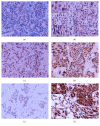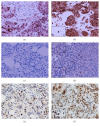Crucial Contributions by T Lymphocytes (Effector, Regulatory, and Checkpoint Inhibitor) and Cytokines (TH1, TH2, and TH17) to a Pathological Complete Response Induced by Neoadjuvant Chemotherapy in Women with Breast Cancer
- PMID: 27777963
- PMCID: PMC5061970
- DOI: 10.1155/2016/4757405
Crucial Contributions by T Lymphocytes (Effector, Regulatory, and Checkpoint Inhibitor) and Cytokines (TH1, TH2, and TH17) to a Pathological Complete Response Induced by Neoadjuvant Chemotherapy in Women with Breast Cancer
Abstract
The tumour microenvironment consists of malignant cells, stroma, and immune cells. Prominent tumour-infiltrating lymphocytes (TILs) in breast cancer are associated with a good prognosis and are predictors of a pathological complete response (pCR) with neoadjuvant chemotherapy (NAC). The contribution of different T effector/regulatory cells and cytokines to tumour cell death with NAC requires further characterisation and was investigated in this study. Breast tumours from 33 women with large and locally advanced breast cancers undergoing NAC were immunohistochemically (intratumoural, stromal) assessed for T cell subsets and cytokine expression using labelled antibodies, employing established semiquantitative methods. Prominent levels of TILs and CD4+, CD8+, and CTLA-4+ (stromal) T cells and CD8+ : FOXP3+ ratios were associated with a significant pCR; no association was seen with FOXP3+, CTLA-4+ (intratumoural), and PD-1+ T cells. NAC significantly reduced CD4+, FOXP3+, CTLA-4+ (stromal) (concurrently blood FOXP3+, CTLA-4+ Tregs), and PD-1+ T cells; no reduction was seen with CD8+ and CTLA-4+ (intratumoural) T cells. High post-NAC tumour levels of FOXP3+ T cells, IL-10, and IL-17 were associated with a failed pCR. Our study has characterised further the contribution of T effector/regulatory cells and cytokines to tumour cell death with NAC.
Figures







Similar articles
-
Tumour-draining axillary lymph nodes in patients with large and locally advanced breast cancers undergoing neoadjuvant chemotherapy (NAC): the crucial contribution of immune cells (effector, regulatory) and cytokines (Th1, Th2) to immune-mediated tumour cell death induced by NAC.BMC Cancer. 2018 Feb 2;18(1):123. doi: 10.1186/s12885-018-4044-z. BMC Cancer. 2018. PMID: 29390966 Free PMC article.
-
Abnormal T regulatory cells (Tregs: FOXP3+, CTLA-4+), myeloid-derived suppressor cells (MDSCs: monocytic, granulocytic) and polarised T helper cell profiles (Th1, Th2, Th17) in women with large and locally advanced breast cancers undergoing neoadjuvant chemotherapy (NAC) and surgery: failure of abolition of abnormal treg profile with treatment and correlation of treg levels with pathological response to NAC.J Transl Med. 2013 Jan 15;11:16. doi: 10.1186/1479-5876-11-16. J Transl Med. 2013. PMID: 23320561 Free PMC article.
-
Natural killer (NK) cell profiles in blood and tumour in women with large and locally advanced breast cancer (LLABC) and their contribution to a pathological complete response (PCR) in the tumour following neoadjuvant chemotherapy (NAC): differential restoration of blood profiles by NAC and surgery.J Transl Med. 2015 Jun 4;13:180. doi: 10.1186/s12967-015-0535-8. J Transl Med. 2015. PMID: 26040463 Free PMC article.
-
Immune infiltrates in the breast cancer microenvironment: detection, characterization and clinical implication.Breast Cancer. 2017 Jan;24(1):3-15. doi: 10.1007/s12282-016-0698-z. Epub 2016 May 2. Breast Cancer. 2017. PMID: 27138387 Review.
-
Prognostic and therapeutic role of tumor-infiltrating lymphocyte subtypes in breast cancer.Cancer Metastasis Rev. 2021 Jun;40(2):519-536. doi: 10.1007/s10555-021-09968-0. Epub 2021 May 7. Cancer Metastasis Rev. 2021. PMID: 33963482 Free PMC article. Review.
Cited by
-
Infiltration of γδ T cells, IL-17+ T cells and FoxP3+ T cells in human breast cancer.Cancer Biomark. 2017 Dec 8;20(4):395-409. doi: 10.3233/CBM-170026. Cancer Biomark. 2017. PMID: 29060923 Free PMC article.
-
Th2 cell infiltrations predict neoadjuvant chemotherapy response of estrogen receptor-positive breast cancer.Gland Surg. 2021 Jan;10(1):154-165. doi: 10.21037/gs-20-571. Gland Surg. 2021. PMID: 33633972 Free PMC article.
-
Implications of metabolism-driven myeloid dysfunctions in cancer therapy.Cell Mol Immunol. 2021 Apr;18(4):829-841. doi: 10.1038/s41423-020-00556-w. Epub 2020 Oct 19. Cell Mol Immunol. 2021. PMID: 33077904 Free PMC article. Review.
-
Benefits in radical mastectomy protocol: a randomized trial evaluating the use of regional anesthesia.Sci Rep. 2018 May 18;8(1):7815. doi: 10.1038/s41598-018-26273-z. Sci Rep. 2018. PMID: 29777144 Free PMC article. Clinical Trial.
-
CTLA-4 Expression and Its Clinical Significance in Breast Cancer.Arch Immunol Ther Exp (Warsz). 2021 Jun 20;69(1):16. doi: 10.1007/s00005-021-00618-5. Arch Immunol Ther Exp (Warsz). 2021. PMID: 34148159
References
-
- Aloysius M., Walker L., Eremin O. Cancer and the immune response. In: Eremin O., Sewell H., editors. Essential Immunology for Surgeons. chapter 4. Oxford, UK: OUP; 2011. pp. 237–302.
MeSH terms
Substances
LinkOut - more resources
Full Text Sources
Other Literature Sources
Medical
Research Materials

